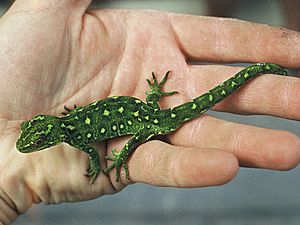West Coast green gecko facts for kids
Quick facts for kids West Coast green gecko |
|
|---|---|
 |
|
| Conservation status | |
 Nationally Vulnerable (NZ TCS) |
|
| Scientific classification | |
| Genus: |
Naultinus
|
| Species: |
tuberculatus
|
| Synonyms | |
|
|
The West Coast green gecko is a special type of gecko found only in New Zealand. It's also known as the Lewis Pass green gecko or the warty tree gecko. Its scientific name is Naultinus tuberculatus. This amazing reptile belongs to the family called Gekkonidae, which includes all geckos.
Contents
Where Does It Live?
Its Home in New Zealand
The West Coast green gecko is an endemic animal. This means it is found naturally in only one specific place in the world. For this gecko, that place is New Zealand. You can find it in the South Island, specifically around Lewis Pass, Rahu, Reefton, and the northern part of Westland.
What's Its Home Like?
Preferred Habitat of the West Coast Green Gecko
This gecko loves to live in trees and bushes. It spends most of its time high up in the branches, especially in manuka and kanuka trees. These trees provide good cover and places for the gecko to hide and hunt.
What Does It Look Like?
Unique Appearance of the Warty Tree Gecko
The West Coast green gecko has a very cool look! Its skin is green, but it has complex patterns of white and yellow. This makes it look a bit like moss growing on a tree, helping it blend in perfectly with its surroundings.
When it opens its mouth, you'll see a bright blue lining. Its tongue is a mix of orange and pink. The gecko's toes are narrow and pointy, usually yellow or yellowish-green. You might also spot a small, bright yellow dot at the corners of its mouth. This gecko can grow up to 85 millimeters long, not counting its tail.
How Does It Live?
Daily Life and Habits
This gecko is diurnal, which means it is active during the daytime. Unlike many other geckos that come out at night, the West Coast green gecko is busy when the sun is shining. It is also arboreal, meaning it lives mostly in trees. It spends its days climbing, hunting, and resting among the branches.
Reproduction and Life Cycle
Young geckos are born between March and May. When they are first born, their markings are much brighter and easier to see than those of the adult geckos. The West Coast green gecko is viviparous. This is a special way of reproducing where the mother gives birth to live young, instead of laying eggs.
Is It Safe?
Conservation Status of the West Coast Green Gecko
The West Coast green gecko needs our help to stay safe. As of 2012, the Department of Conservation (DOC) in New Zealand has classified it as "Nationally Vulnerable." This means there are concerns about its population, and it needs protection to ensure it thrives in the future.

